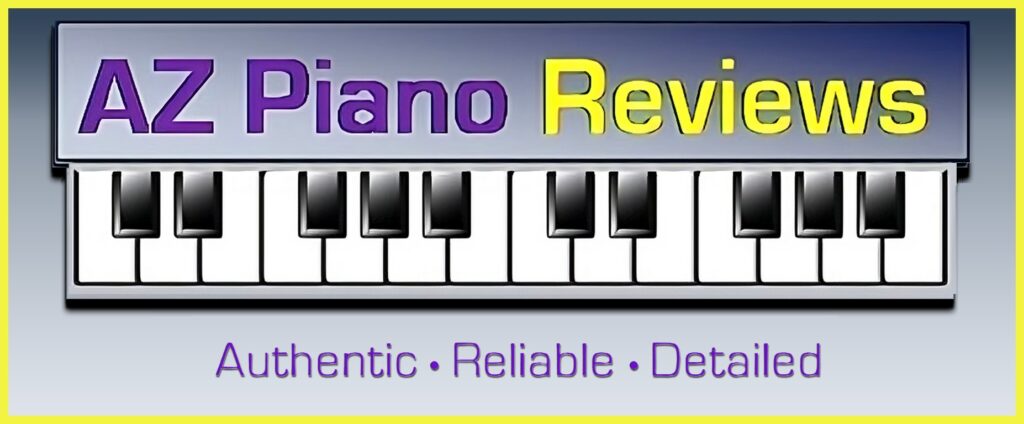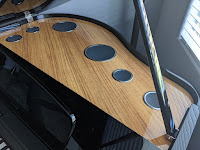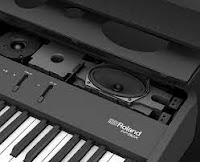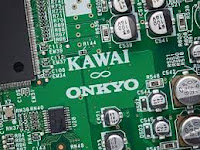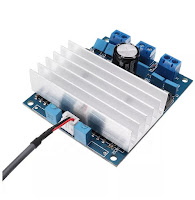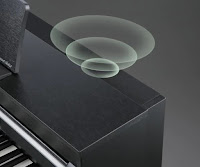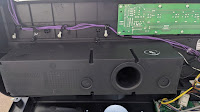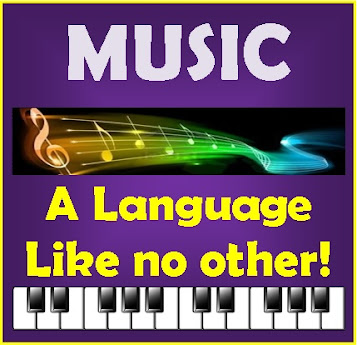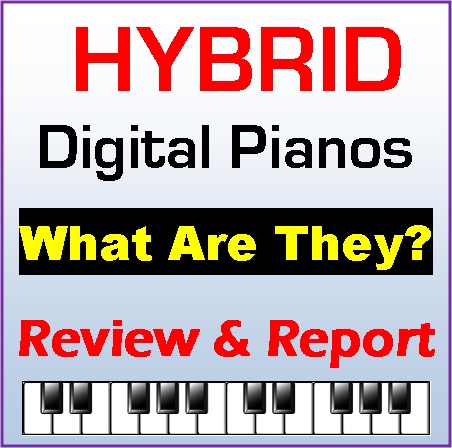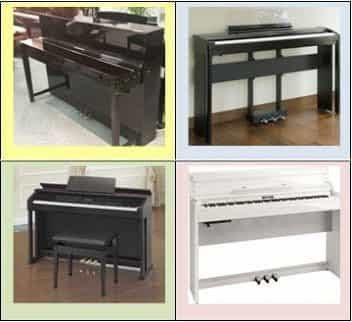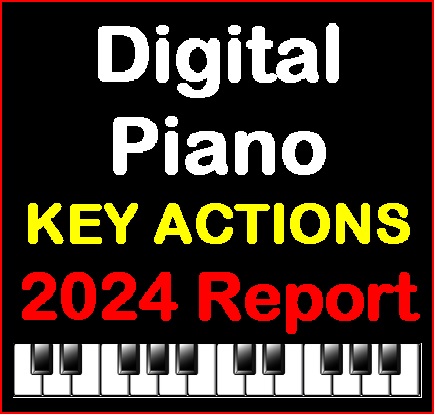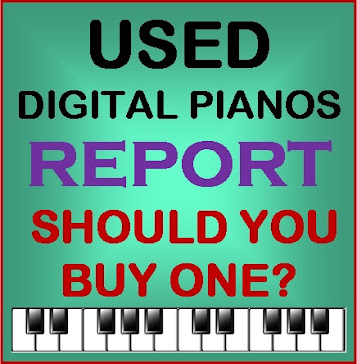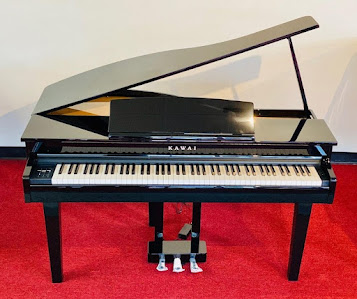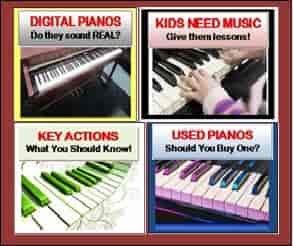INTRODUCTION
Digital Pianos are very popular these days and there are many to choose from in a variety of brands. Each model has its own specifications and they can vary from one digital piano to another. You might see various descriptive words in their specifications such as number of keys, key action type, weighted keys, unweighted keys, touch sensitivity, pedals, functions, display, polyphony, voices, tone generation, reverb, layer, spilt, songs, recording, playback, transpose, storage, MIDI, USB, Bluetooth, connectivity, and many other specs in the various digital pianos.
But a very important specification that many shoppers tend to overlook is the internal speaker system. Namely, speaker size, amount of speakers, quality of speakers, placement of internal speakers, do they have passive bass speaker ports, good amplification power, and how many amplifiers are in that digital piano vs how many speakers?
PORTABLE “STAGE” DIGITAL PIANOS
There are some digital pianos that are called portable “stage” digital pianos. They are mostly used by musicians or other players who want a portable instrument without internal speakers because they are either playing music on stage at some venue which has their own external speaker system and external monitors or that musician only wants to use external speakers for some other reason such as having a sound guy at an external mixing board running sound remotely so that he can adjust volumes, etc for the audience to hear it good… like in a big stadium, concert hall, church, or other large venues.
Having a “stage” digital piano does not necessarily make that piano better than other digital pianos which have internal speakers, but a stage type digital piano may have certain functions or features on it that could be more appealing to that particular player or pro musician that digital pianos with internal speaker systems do not have.
An exception to that is if you have a home or pro recording studio and you want many “pro” features, functions, and sounds in the digital piano for recording purposes that a regular portable digital piano may not have.
PORTABLE “SELF CONTAINED” DIGITAL PIANOS
The more popular portable digital pianos have an internal speaker system, unlike the portable the stage digital pianos that have no internal speakers. When a portable digital piano has an internal speaker system then they are referred to as being “self-contained.” These portable “self-contained” digital pianos are more practical in my opinion because you can hear it through its own speaker system rather than always connecting to an external sound system.
sometimes giving you a “bigger bang for the buck” as compared to furniture cabinet digital piano in the same price range.
HOME CABINET DIGITAL PIANOS
But for home use in a cabinet digital piano, generally speaking, the furniture cabinet digital piano you would want to purchase should have its own internal speaker system that is powerful enough and has enough quality to provide you with a very full and resonant piano sound, without getting distortion. That internal speaker system needs to be good for your playing skills and musical goals as well as for the room you are putting it in. It is important to have good, resonant piano sound and that’s why it is important to look at the digital piano specification when it comes to its speakers and amplifiers. It doesn’t matter what size or the cost of the digital piano you want to get. Make sure the sound is going to be heard in a way that you will not regret.
If the speaker system is underpowered then the piano and other instruments and features in it could sound somewhat anemic and artificial when you play your music. Also the piano may not have enough power and/or presence to fill up the room that you are playing in as well as maybe not having good bass response. Watching demo videos on-line of digital pianos will not let you hear the true sound coming through the speakers because of the way those recordings are done.
WHAT DO YOU REALLY NEED?
Therefore, it’s important to know what speaker system is in the digital piano you are looking at and how much do you really want and need in terms of speaker quality, size, and power. Overall it can be a somewhat confusing subject. Regardless, normally the more you pay for a digital piano the better the internal speaker system gets.
As an example, in the new low end Yamaha Arius model called the YDP-105 which sells for $1100, it has just 2 amplifiers with a total of 12 watts of power going through
2 speakers measuring 4.7″ each. For $1100 that speaker system is much too small in my opinion. Yamaha could have done much better, especially for that higher price.speakers measuring 3.1″ each help carry the higher end treble frequencies. The speakers and amps are also higher quality and they have much better internal placement in the Clavinova CLP-745.
CHOOSING INTERNAL SPEAKER SYSTEMS
So with all that being said, here’s my rule of thumb for a better sound experience in a digital piano. In a portable digital piano, make sure it has at least 16 watts of power going through a minimum of two 4″ speakers coming out near and/or on the top of the piano pointing towards you.
CHOOSING AMPLIFIER POWER
The thing that more amplifier power (wattage) does in a digital piano, especially in a furniture cabinet digital piano, is allow that piano to project its piano sound further with better tone and clarity and generally much better bass response as well. Furniture cabinet digital pianos that have just 12 or 16 watts of power are underpowered in my opinion and I have played those digital pianos and personally experienced them, and generally don’t like them.
The more speakers, amplifiers, and power in a digital piano, generally the better off you will be. There are some caveats to that equation, however. Let’s say a digital piano has slightly lower amplifier wattage power as compared to another digital piano in the same price range. But maybe that piano has more speakers and also better speakers in it.
SPEAKER POSITION & SOUND DIRECTION
Also, the direction in which the internal speakers are pointing can have a lot to do with how you hear the sound and the impact those directional speakers will have on your piano playing experience. If the speakers are under the piano pointing down to the floor, then that would not be as good as the speakers pointing up along with speakers pointing towards you. A perfect example of 4 speakers with each pair pointing in different directions along with 4 separate amplifiers powering each speaker would be the Korg G1 Air at $1999.
This Korg model has an internal speaker system at $1999 that surpasses many digital pianos up to about $3500. So when it comes to “price” in a digital piano, it’s still a relative thing when it has to do with the internal speaker system. A higher price in a digital piano does not always equate to a better internal speaker system over a lower price digital piano, although in many cases it does. You’ll just need to contact us when you are doing your “shopping” so that you make the right decision.
DIGITAL PIANO SPEAKER SYSTEM CHART
Below is chart of nearly all the top current 88-key digital pianos under $8000 that have internal speaker systems. I picked the price range under $8000 because that will cover most models out there from the top brands. There are a few other models above $8000 so if you want that info then please contact us. The prices listed for the upright or portable style digital pianos are in the matte finishes, although some of them are available in polished ebony and polished white finishes for more money.
|
2023
Models |
Piano
Price
|
Total
Speakers |
Speaker
Size |
Total
Amplifiers |
Total Amp
Power |
|
Yamaha P45 |
$550
|
2 |
4.7″x 2 |
2 |
12 watts |
|
Yamaha P125 |
$700 |
4 |
4.7″x 2 1.5″x 2 |
2 |
14 watts |
|
Yamaha P515 |
$1600 |
4 |
4.7″x 2 1″x 2 |
4 |
40 watts |
|
Yamaha DGX670 |
$850 |
4 |
4.7″x 2 2″x 2 |
2 |
12 watts |
|
Yamaha YDP105 |
$1100 |
2 |
4.7″x 2 |
2 |
12 watts |
|
Yamaha YDPS35 |
$1200 |
2 |
4.7″x 2 |
2 |
16 watts |
|
Yamaha YDP145 |
$1300 |
2 |
4.7″x 2 |
2 |
16 watts |
|
Yamaha YDPS55 |
$1600 |
2 |
4.7″x 2 |
2 |
40 watts |
|
Yamaha YDP165 |
$1800 |
2 |
4.7″x 2 |
2 |
40 watts |
|
Yamaha YDP184 |
$2400 |
2 |
6.3″x 2 |
2 |
60 watts |
|
Yamaha CLP725 |
$2000 |
2 |
4.7″x 2 |
2 |
40 watts |
|
Yamaha CLP735 |
$2900 |
2 |
6.3″x 2 |
2 |
60 watts |
|
Yamaha CLP745 |
$3700 |
4 |
6.3″x 2 3.1″x 2 |
4 |
200 watts |
|
Yamaha CLP-775 |
$5000 |
4 |
6.3″x 2 3.1″x 2 2″x 2 Transducer |
6 |
284 watts |
|
Yamaha CLP785 |
$6200 |
9 |
6.3″x 2 3.1″x 2 1″x 2 transducers x 2 Spruce Cone Spkr |
6 |
300 watts |
|
Yamaha CLP765GP |
$5900 |
4 |
6.3″x 2 2″x 2 |
4 |
184 watts |
|
Yamaha CLP795GP |
$8200 |
9 |
6.3″x 2 3.1″x 2 1″x 2 transducers x 2 Spruce Cone Spkr |
6 |
300 watts |
|
Yamaha CSP150 |
$3799 |
2 |
6.3″x 2 |
2 |
60 watts |
|
Yamaha CSP170 |
$5149 |
4 |
6.3″x 2 3.1″x 2 |
4 |
180 watts |
|
|
Price |
Speaker quantity |
Speaker sizes |
Amplifier quantity |
Amp power |
|
Roland FP30X |
$750 |
2 |
4.7″x 2
|
2 |
22 watts |
|
Roland FP60X |
$1250 |
2 |
4.7″x 2 spkr box |
2 |
26 watts |
|
Roland FP90X |
$2000 |
4 |
4.7″x 2 1″x 2 w/spkr box |
4 |
60 watts |
|
Roland F107 |
$1100 |
2 |
4.7″x 2 |
2 |
16 watts |
|
Roland RP107 |
$1200 |
2 |
4.7″x 2 |
2 |
16 watts |
|
Roland F701 |
$1600 |
2 |
4.7″x 2 |
2 |
24 watts |
|
Roland RP701 |
$1750 |
2 |
4.7″x 2 |
2 |
24 watts |
|
Roland HP702 |
$2800 |
2 |
4.7″x 2 |
2 |
28 watts |
|
Roland HP704 |
$3750 |
6 |
4.7″x 2 1″x 2 2″x 2 |
4 |
60 watts |
|
Roland LX705 |
$4400 |
6 |
4.7″x 2 1″x 2 w/spkr box 1″x 2 dome |
4 |
60 watts |
|
Roland LX706 |
$5400 |
6 |
9.8″x 2 w/spkr box 12″x 2 w/spkr box 1″x 2 |
6 |
74 watts |
|
Roland LX708 |
$7600 |
8 |
9.8″x 2 w/spkr box 4.7″x 2 w/spkr box 4.7″x 2 1″x 2 |
8 |
74 watts |
|
Roland GP6 |
$6299 |
5 |
10″ x 1 w/spkr box 4.7″x 2 2″x 2 |
5 |
100 watts total |
|
|
Price |
Speaker quantity |
Speaker sizes |
Amplifier quantity |
Amp Power |
|
Casio CDPS160 |
$529 |
2 |
4.7″x 2 |
2 |
16 watts |
|
Casio CDPS360 |
$599 |
2 |
5.1″x 2 |
2 |
16 watts |
|
Casio PXS1100 |
$699 |
2 |
6.3″x 2 Oval |
2 |
16 watts |
|
Casio PXS3100 |
$879 |
2 |
6.3″x 2 Oval |
2 |
16 watts |
|
Casio PXS5000 |
$1200 |
2 |
6.3″x 2 |
2 |
16 watts |
|
Casio PX-S6000 |
$1800 |
4 |
6.3″x 4 spatial sound |
4 |
32 watts |
|
Casio PXS7000 |
$2500
|
4 |
6.3″x 4 spatial sound |
4 |
32 watts |
|
Casio PX770 |
$899 |
2 |
4.7″x 2 |
2 |
16 watts |
|
Casio PX870 |
$1199 |
4 |
4.7″x 2 1.5″x 2 |
2 |
40 watts |
|
Casio AP-270 |
$1199 |
2 |
4.7″x 2 |
2 |
16 watts |
|
Casio AP470 |
$1699 |
4 |
4.7″x 2 1.5″x 2 |
2 |
40 watts |
|
Casio AP710 |
$2799 |
6 |
4.7″x 4 2″x 2 |
2 |
60 watts |
|
Casio GP310 |
$4299 |
6 |
6.3″x 2 4″x 2 2″x 2 |
4 |
100 watts |
|
Casio GP510 |
$6299 |
6 |
6.3″x 2 4″x 2 2″x 2 |
4 |
100 watts |
|
|
Price |
Speaker quantity |
Speaker sizes |
Amplifier quantity |
Amp power |
|
Kawai ES120 |
$949 |
2 |
4.7″x 2 |
2 |
20 watts |
|
Kawai KDP75 |
$999 |
2 |
4.7″x 2 |
2 |
18 watts |
|
Kawai KDP120 |
$1499 |
2 |
4.7″x 2 |
2 |
40 watts |
|
Kawai ES520 |
$1399 |
2 |
4.7″x 2 w/bass port |
2 |
40 watts |
|
Kawai ES920 |
$1899 |
2 |
4.7″x 2 w/bass ports |
2 |
40 watts |
|
Kawai CN201 |
$2299 |
2 |
4.7″x 2 |
2 |
40 watts |
|
Kawai CN301 |
$3099 |
4 |
5.1″x 2 4.7″x 2 |
2 |
40 watts |
|
Kawai CA401 |
$3099 |
4 |
5.1″x 2 2″x 2 |
2 |
40 watts |
|
Kawai CA501 |
$3999 |
4 |
5.1″x 2 4.7″x 2 |
2 |
100 watts |
|
Kawai CA701 |
$4899 |
6 |
5.1″x 2 4.7″x 2 2″x 2 |
2 |
110 watts |
|
Kawai CA901 |
$6399 |
6 + wood soundboard |
4.7″x 2 3.1″x 2 2″x 2 |
3 |
135 watts |
|
Kawai DG30 |
$6099 |
4 |
5.1″x 2 4″x 2 |
2 |
40 watts |
|
|
Price |
Speaker quantity |
Speaker sizes |
Amplifier quantity |
Amp power |
|
Korg B2 |
$599 |
2 |
5″x 2 w/spkr box |
2 |
30 watts |
|
Korg SP-280 |
$1000 |
2 |
6.3″x 2 |
2 |
44 watts
|
|
Korg LP180 |
$750 |
2 |
6.3″x 2 |
2 |
22 watts |
|
Korg XE20 |
$849 |
2 |
5″x 2 w/spkr box |
2 |
36 watts |
|
Korg LP380U |
$1349 |
2 |
4″x 2 in spkr box |
2 |
44 watts |
|
Korg C1 |
$1599 |
2 |
4″x 2 in spkr box |
2 |
50 watts |
|
Korg G1 Air |
$1999 |
4 |
4.7″x 2 in spkr box 1″x 2 |
4 |
80 watts |
|
Korg SV288SP |
$2450 |
2 |
1″x 2 3″x 2 passive radiator |
2 |
30 watts
|
